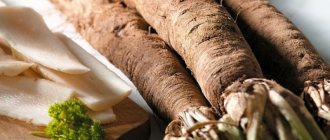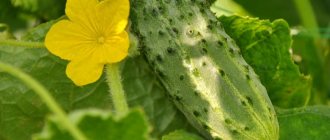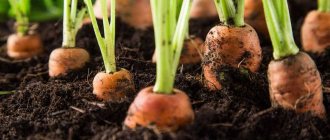What does it look like?
Tops
Purple carrots have spreading tops with characteristic needle-shaped leaves of a juicy green color. In appearance, the plant does not differ from the classic orange carrot .
Roots
The length of the vegetable can reach 20-30 cm. The outside of the root vegetable is painted bright purple, and inside it has an orange or yellow core. Also, the cut can also be painted purple, but of a slightly different shade, like beets. There are varieties that can have several colors on the cut - yellow, orange and purple (read about yellow varieties of carrots here).
How a person met carrots
There is no exact and reliable information about how people met this root vegetable, but there is a rather interesting version of such a meeting. More than 4,000 years ago, a man noticed that a horse was happily chewing some kind of purple plant. Having become interested, he took the carrots from the animal, and he liked it.
Having remembered what the leaves of the tasty root looked like, the man went in search of it. Taking into account all subsequent events, wild purple carrots came to taste and they began to cultivate them.
Varieties
Purple carrots do not come in as many varieties as regular carrots, but several varieties are widely available for purchase.
Dragon
The root vegetables have a deep purple color and a yellow core . They reach 25 cm in length, have a sweet taste and a high content of vitamin A. Seeds can be purchased in specialized stores. The price for a bag of seeds varies between 100-150 rubles.
Purple Elixir
Root vegetables are easily distinguished from other varieties by their purple-violet color. In cross section, they are three-colored - an orange core, an intermediate yellow layer and a purple outer layer. Planting material is widely available for purchase at gardening stores. Cost – 120-150 rubles per bag.
Purple Haze
The fruits of this hybrid are dark purple on the outside and orange on the inside. The variety is early ripening and already 70 days after emergence it grows up to 30 cm in length. Resistant to diseases.
It is almost impossible to find planting material of this variety in markets, but it can easily be purchased via the Internet or in specialized stores.
The cost of a bag of seeds is 130-160 rubles.
Cosmic Purple
Early ripening variety. The vegetable has a purple color with a raspberry tint due to its thin, brightly colored skin. The inside of these carrots is a classic orange color. Very juicy and crispy fruits, 20 cm long. Planting material can be purchased at gardening stores online or offline. The price for a bag of seeds varies between 90-140 rubles.
The most common varieties, description and characteristics
Dragon is the most common purple carrot.
Before planting purple-blue carrots, you need to familiarize yourself with the most common varieties.
Dragon
This is an early variety that was developed from Chinese carrots in the second half of the 20th century. The uniqueness of this root vegetable lies in the fact that despite the purple color, there is an orange core hidden inside.
Dragon is ideal for home growing. It tolerates temperature changes and high humidity. Also, the variety is undemanding in care and does not require frequent watering.
Purple Haze
A hybrid early variety that was bred for cultivation in cold climates. The place of origin of the Violet Haze is Holland. The main feature of this carrot is the rapid ripening of the root crop. It manages to ripen within two months after planting in the garden.
The original color of this carrot is purple. However, sometimes there are root vegetables with a bluish tint. They have a cone shape, with a slightly pointed tip. The fruits grow up to 20 centimeters in length.
Chemical composition of root vegetables
According to research, the chemical composition of purple carrots is much richer than that of regular orange ones. It contains perfectly balanced vitamins and minerals. The root vegetable is rich in beta and alpha carotene, and its unusual color is due to the presence of anthocyanin in the substance. Vitamins included in the composition: B3, B1, B2, B5, B6, B9, C, E, H, K, PP.
Minerals:
- calcium;
- magnesium;
- sodium;
- potassium;
- phosphorus;
- chlorine;
- sulfur;
- iron;
- zinc;
- iodine;
- copper;
- manganese;
- selenium;
- chromium;
- fluorine;
- molybdenum;
- boron;
- vanadium;
- cobalt;
- lithium;
- aluminum;
- nickel.
Feed carrots: types, varieties, photos
Feed carrots are grown for inclusion in the diet of cattle and small domestic animals. The vegetable root is cylindrical or elongated-conical, and its length ranges from 30 to 50 cm. In some varieties of carrots, it may have a cylindrical shape with a rounded end.
- Varieties of white fodder carrots: Arnimkrivenskaya white, White greenhead, Belgian white, Berlin giant, White Weibull, Vosges white, Gigantic white, Thick, Championship.
- Varieties of yellow fodder carrots: Long green-headed giant, Yellow giant Weibull, Saalfelder yellow, Lobberich yellow carrot, Half-long Arnimkrivensky, Palatinate golden yellow, Flanders.
- Varieties of red fodder carrots: Long orange-red giant, Long thick blunt-pointed giant, Long red Altringham, Long red Brunswick, Gigantic red, Red thick, Orange-yellow Dippe.
Benefits and harms
- Purple carrots are the richest source of vitamin A. Eating the root vegetable helps relieve fatigue, improves vision and alleviates some ophthalmic diseases, such as cataracts.
- The vegetable also slows down the aging process in the body, strengthens the immune system and, in complex therapy, helps to recover from heart and vascular diseases.
- The anthocyanin contained in the composition is effective in preventing cancer.
Purple carrots can cause harm in case of individual intolerance or abuse.
It is recommended to limit the consumption of this vegetable to people suffering from stomach ulcers or inflammation of the small intestine.
What is its use
Thanks to the presence of “purple” pigments – anthocyanins – this purple vegetable exhibits the following beneficial properties:
- Anticancer effect. A substance found in purple carrots, the carotenoid lutein, helps anthocyanins to noticeably slow down the growth of cancer cells.
- Anti-inflammatory effect.
- Helps strengthen the immune system.
- It is an excellent means of preventing diseases of the cardiovascular system.
- It helps well with diseases of the vascular system, especially with varicose veins and venous insufficiency.
- Helps improve vision and serves as an excellent preventive measure against the development of retinopathy in patients with diabetes.
- Normalizes and stabilizes cholesterol levels in the blood.
- Reduces high blood pressure.
- Strengthens the kidneys.
- Calcium contained in purple carrots along with other beneficial substances is easily absorbed by the body and helps maintain good skin, nails and hair.
- Regular consumption is a good remedy in the fight against various sexual dysfunctions in both men and women.
Step-by-step instructions: how to grow?
Purple carrots have fairly simple agricultural technology, and the features of caring for them are similar to those used for orange carrots .
Preparing for landing
- Inventory . To organize the garden bed you will need a shovel and a rake. The grooves can be made using a special small flower spatula. You will also need a watering can with a nozzle with small holes.
- Soils . The best predecessors for carrots are potatoes, onions, and cucumbers. The soil must be fertile and well fertilized.
- Semyon . Before planting, the seeds must be soaked for a day - this will speed up their germination and help identify non-viable seed.
Planting process
- Landing dates . Carrot seeds are sown in the ground in early spring. Purple varieties have good germination.
- Planting scheme . The seeds are distributed in the garden bed in rows with an interval of 1-2 cm. 15-20 cm should be left between the rows.
Care
- Suitable microclimate . Carrot plantings do well at temperatures of +23+26 and are quite unpretentious in matters of humidity. The main thing is to follow the watering regime. If the weather is hot, carrot tops can be sprayed.
- Watering . Carrot plantings should be watered with warm, settled water in the evening. Moisture should be completely absorbed into the ground without the formation of puddles and stagnation.
- Feeding . Carrots are fed at least twice during the season. The first feeding is carried out in the phase of 3-4 leaves with ammonium nitrate. The second - after the final thinning, using superphosphate fertilizers.
- Loosening . After the carrot seedlings have become stronger, it is necessary to regularly loosen the soil. This will help avoid the formation of a crust on the ground.
- Weeding . The first thinning is carried out after the appearance of 1-2 true leaves. Large seedlings should be left at a distance of at least 2 cm from each other.
- Mulching . You can mulch purple carrots with chopped straw; this will perfectly retain moisture and eliminate the need to loosen the soil.
Harvesting and storage
Purple carrots have lower yields than orange varieties.
- If an early ripening variety was planted, the harvest can be harvested in mid-summer.
- Medium-ripening varieties are harvested 80-110 days after emergence.
- Late-ripening purple carrots are harvested in the fall, in the first two weeks of September in dry weather.
The differences between varieties based on ripening time are described here.
The harvest should be stored in a cool, well-ventilated, dry room, where rodents and harmful insects do not have access.
The purple root vegetable is not a frequent guest on tables. In our articles you can read about other varieties of carrots: Dutch, black, white, as well as Children's Sweetness and Flakke.
List of mistakes and how to avoid them
- Thickening of plantings . Purple carrots have good germination, so do not sow the garden bed with seeds. Emerging seedlings must be thinned out in a timely manner.
- Uneven watering . Failure of the irrigation regime leads to deformation and cracking of the fruit, so you should strictly adhere to the recommended scheme.
- Adding fresh organic matter . You cannot fertilize carrots with fresh manure. Excess nitrogen harms the plant.
- Planting seeds in heavy soil with high acidity . The soil for planting carrots must be carefully prepared, balancing all the indicators.
Harvest and storage
The cellar is ideal for long-term storage of root vegetables
When harvesting ripe carrots, you will need a fork or bayonet shovel. With their help, you need to carefully dig up the root crops without damaging them. It is not worth harvesting the ripe crop manually, as it is quite difficult.
After harvesting, carrots must be carefully sorted and spoiled vegetables should be thrown away. Then the fruits are dried and placed in a cellar for further storage.
Many people do not know that carrots were originally purple and consider varieties with this color to be something unusual. Gardeners who want to plant carrots with purple fruits must first understand the peculiarities of growing them at home.
Diseases and pests and their prevention
Purple carrots are highly resistant to diseases and pest attacks , so when growing any of its varieties, prevention is quite effective.
- Fomoz . The disease affects root crops; they become covered with black-brown spots with a white coating. Fertilizing with nitrogen helps prevent disease.
- White rot . Fruits affected by this disease become soft and covered with a white coating. The disease is treated by applying potassium supplements.
- Carrot fly . It damages root crops and the tops acquire a bronze tint. Timely removal of weeds will help prevent the pest from attacking, and to get rid of the insect, carrots are treated with insecticidal preparations.
Errors during cultivation
When growing yellow carrots, the following mistakes and their consequences are possible:
- lack of thinning – root crops are small, yield is lower;
- lack of watering - poor growth, cracking of fruits;
- manure and droppings for fertilizer - distortion of fruits;
- Late harvest means fruits are unsuitable for food.
Yellow carrots are a variety of crops distinguished by their color, fruit sweetness and chemical composition. There are several common plant varieties that have certain characteristics. You need to grow yellow carrots correctly, taking into account typical mistakes and their consequences.
Copy link
How to use?
In cooking, purple carrots have found the same use as their orange version.:
- Root vegetables can be boiled and stewed.
- Bake and steam.
- Use for desserts.
- Consume fresh.
- The vegetable is great for making marinades and juices.
- Can be used to decorate other dishes.
The beneficial properties of ordinary carrots are known to everyone, and the positive effect of orange root vegetables on the body is undeniable. But it is important to know that unusually beautiful purple varieties of carrots can add not only an aesthetic component to the diet, but also an increased content of substances necessary to maintain health.
Purple carrots: reviews
Those who have already grown an unusual vegetable in their garden were very pleased with the result and advise other gardeners to grow purple carrots in their garden, because the root crop differs not only in color, but also has better taste and contains more vitamins and other useful substances, compared to ordinary carrots. Also, according to reviews, people confirm the promised 100% germination of seeds and the unpretentiousness of the plant, since they had to care for carrots in exactly the same way as their orange sister.
Purple carrots are an inexpensive and very healthy food product that every person who cares about their health and monitors the health of their family can afford. In addition, the vegetable grows well in all regions of Russia. You may surprise your neighbors with the color of an unusual root vegetable, but the benefits of the product remain at the highest level, both for ordinary carrots and for the Overseas beauty.











